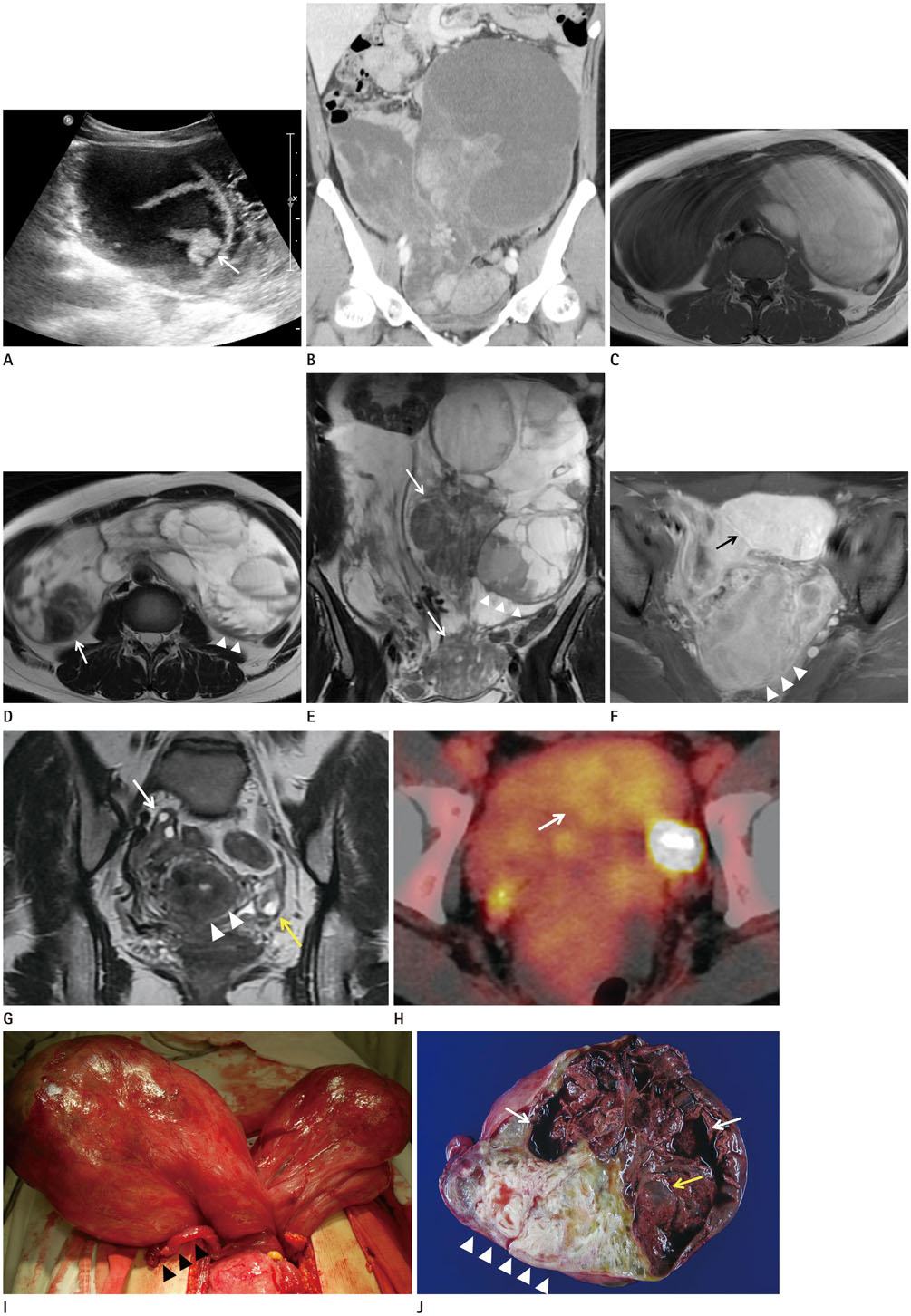J Korean Soc Radiol.
2017 Jul;77(1):61-66. 10.3348/jksr.2017.77.1.61.
Degenerated Uterine Leiomyomas Mimicking Malignant Bilateral Ovarian Surface Epithelial Tumors
- Affiliations
-
- 1Department of Radiology, Bucheon Hospital, Soonchunhyang University College of Medicine, Bucheon, Korea. rad1995@schmc.ac.kr
- 2Department of Obstetrics and Gynecology, Bucheon Hospital, Soonchunhyang University College of Medicine, Bucheon, Korea.
- KMID: 2384738
- DOI: http://doi.org/10.3348/jksr.2017.77.1.61
Abstract
- Uterine leiomyomas are the most common benign uterine neoplasms. Undegenerated uterine leiomyomas are easily recognizable by the typical imaging findings on radiologic studies. However, degenerated fibroids can have unusual and variable appearances. The atypical appearances due to degenerative changes may cause confusion in diagnosis of leiomyomas. In this article, we report a case of a patient with extensive cystic and myxoid degeneration of uterine leiomyoma, mimicking malignant bilateral ovarian surface epithelial tumors.
MeSH Terms
Figure
Reference
-
1. Karagianni E, Tsolakidis D, Bili E, Vavilis D, Tarlatzis B. Degeneration of a pedunculated leiomyoma mimicking ovarian neoplasm. A case report and review of the literature. Obstet Gynecol Int J. 2015; 14:87–89.2. Novak ER, Woodruff JD. Myoma and other benign tumors of the uterus. In : Novak E, Novak ER, Woodruff JD, editors. Gynecologic and obstetric pathology: with clinical and endocrine relations. 6th ed. Philadelphia: WB Saunders;1967. p. 260–279.3. Hillard PJ. Benign diseases of the female reproductive tract. In : Berek JS, editor. Berek and Novak's gynecology. 15th ed. Philadelphia: Lippincott Williams & Wilkins;2012. p. 374–437.4. Mayer DP, Shipilov V. Ultrasonography and magnetic resonance imaging of uterine fibroids. Obstet Gynecol Clin North Am. 1995; 22:667–725.5. Murase E, Siegelman ES, Outwater EK, Perez-Jaffe LA, Tureck RW. Uterine leiomyomas: histopathologic features, MR imaging findings, differential diagnosis, and treatment. Radiographics. 1999; 19:1179–1197.6. Ueda H, Togashi K, Konishi I, Kataoka ML, Koyama T, Fujiwara T, et al. Unusual appearances of uterine leiomyomas: MR imaging findings and their histopathologic backgrounds. Radiographics. 1999; 19 Spec No:S131–S145.7. Kaushik C, Prasad A, Singh Y, Baruah BP. Case series: cystic degeneration in uterine leiomyomas. Indian J Radiol Imaging. 2008; 18:69–72.8. Low SC, Chong CL. A case of cystic leiomyoma mimicking an ovarian malignancy. Ann Acad Med Singapore. 2004; 33:371–374.9. Wilde S, Scott-Barrett S. Radiological appearances of uterine fibroids. Indian J Radiol Imaging. 2009; 19:222–231.10. Kim HC, Cho JH. Endometrial stromal sarcoma presented as a multilocular cystic mass without a solid component: a case report. J Korean Soc Radiol. 2012; 66:543–546.
- Full Text Links
- Actions
-
Cited
- CITED
-
- Close
- Share
- Similar articles
-
- A Study on Expression of p53 Protein according to Histologic Types, Degree of Malignancy and Differentiation of the Ovarian Surface Epithelial Tumors
- Cyclooxygenase-2 Expression in Ovarian Tumors
- Expression of E-cadherin in Benign, Borderline, and Malignant Ovarian Epithelial Tumors
- Two Cases of Uterine Tumors Resembling Ovarian Sex-cord Tumors: Rare Case of Uterine Tumor
- Current Medical Therapy for Uterine Leiomyomas


